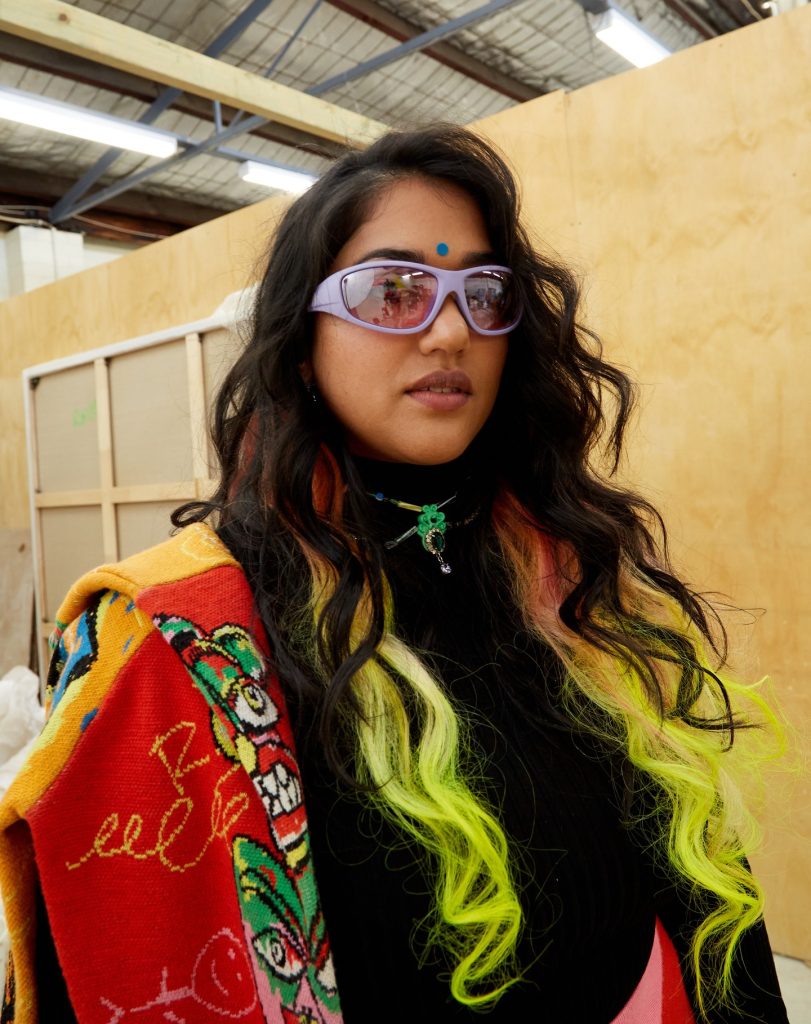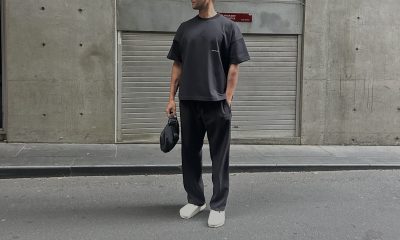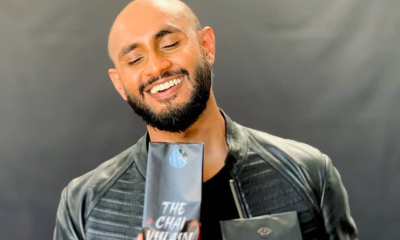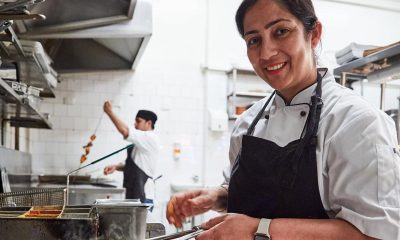Arts
Archibald Prize Finalist Kirthana Selvaraj’s Latest Exhibition, ‘Making Space’, Examines Brown and Black Identity
In conversation with South Asian Australian artist Kirthana Selvaraj on her latest exhibition ‘Making Space’.

Ever wondered what happens when a budding biotechnologist swaps petri dishes for paint palettes? Enter Sydney-based Archibald Prize-finalist Kirthana Selvaraj—a queer, South Asian Australian artist who found her true calling in strokes of a paintbrush rather than DNA strands.
The world around me felt very rigid and inaccessible, but drawing felt like a bit of power, where I could decide what had value, what could be special.
Like wine, art is something that we at Brown Boy Magazine know very little about. Except, perhaps, that art rhymes with fart. And fart is a funny word, whatever age you are. Now, that doesn’t mean we can’t appreciate wine or art or wine and art, but, you know, we’ll leave the painting to the experts and stick to fart jokes. Because, thankfully, there’s Kirthana—our compass in this universe of colour and canvas.
Kirthana’s latest exhibition, Making Space, is in full swing at Flinders Lane Gallery in Melbourne/Naarm and runs until 26 August 2023. With Making Space, Kirthana portrays the daily, nuanced lives of Black and Brown creators, offering a poignant reflection of their humanity. It’s an archive, an anecdote, and an affirmation of identities, all melded into one.
I painted people who don’t traditionally get painted within the history of western portraiture or beyond art history, in these more complex ways. Often Black and Brown bodies have been depicted as a way of anthropological taxonomy, almost always through a colonial gaze. I wanted to paint as to reveal the humanity of the body that I see, not abstracting it from the context of the places which it navigates, but to situate it within the fields in which it operates and moves in, and the spaces in which it is carving out even more space for others to also step into.
Kithana Selvaraj on ‘Making Space’ via Flinders Lane Gallery
Brown Boy Mag recently caught up with Kirthana to learn more about Making Space, her experience as a queer, South Asian Australian artist, and the conversations she wants to inspire through her work. For up-and-coming artists, Kirthana’s advice was straightforward: foster relationships, build communities and find joy in every interaction.
Our conversation has been edited for clarity and concision.
Brown Boy Magazine: Your work explores deeply personal themes around your queer and South Asian identities. Did you always know that art was your calling? And how have your personal experiences and identity shaped your art?
Kirthana Selvaraj: Some of my earliest memories are of me drawing, and I remember it being the first time I ever truly felt confident in myself. It made me discover a part of myself that I couldn’t really quantify or explain, and I liked that.
The world around me felt very rigid and inaccessible, but drawing felt like a bit of power, where I could decide what had value, what could be special.
I had felt the pressures that many from the diaspora experience of settling into the more recognisably ‘secure’ professions. At the time, I started a path into Biotechnology but quickly found that there was something else pulling at me.
Art making always hummed in the background, and it was only when I actually gave myself permission to pursue something potentially joyful did it position itself at the front. Art school was interesting, less because I learned how to be an artist and more so because I learned what I didn’t want to be. Painting has been declared dead time and time again, a dead genre, but I loved it so much—something about pigment suspended in medium, the colour, the kind of alchemy of it all made me choose it over and over again.
BB: Your upcoming exhibition, Making Space, originally aimed to present a sort of alternative archival history of Black and Brown creators, but transformed into something more nuanced. It challenges the traditional portrayal of Black and Brown bodies through a colonial gaze and aims to reveal their humanity. Can you tell us more about the concept, your inspiration and why this imagery is significant to you?
Kirthana Selvaraj: I’m really interested in figuration. Throughout art history and within the Western canon, specifically painting, Black and Brown bodies were largely excluded and relegated to positions of servitude or passivity. When depicted outside of this, they were often fetishised or orientalised; there was an absence of seeing them in their totality, which is complex. This is certainly important for me to explore, but as I was connecting with my subject, I noticed a common thread, one that moved beyond an idea of representation and expanded the idea of what it means to take up space, to make space, to choose, to re-imagine. These are all very human things; each of the subjects was in some way negotiating. I wanted to capture vignettes of nuanced lives of the everyday.
BB: Making Space features some celebrated individuals from the South Asian Australian diaspora—namely, Vidya Rajan. How did you choose the various Black and Brown creators featured in Making Space?
Kirthana Selvaraj: In some ways, it was initially about those who took up space in my own world through the clothes I wore, the books I read, and the music and culture I surrounded myself with. People who were carving out space in their own respective fields, be that in a more overtly didactic way or just in the way they live and love in fullness. I personally resonated with all of them in some way, seeing myself refracted in their work.
BB: Your art provides an opportunity for people of colour from the diaspora to explore what “making space” means to them. How do you hope we engage with your work, and what conversations do you want to stimulate?
Kirthana Selvaraj: Of course, I want people from the diaspora to feel seen, perhaps in a space that doesn’t always do so, but I think making space is also just as much about the cross-section of the personal or creative, transitory, geographic changes that each subject was shifting into, by starting again, discarding, or changing directions.
I hope that whoever is interacting with the work notices something different in each painting that pulls at you in a different way. As Queer POC, we are not a monolith; navigating the world differently, using materiality differently and creating our spaces differently.
BB: The challenges as a South Asian Australian creative are manifold. How has your experience been as a queer, South Asian Australian creative in the broader Australian art world? And what advice would you give other South Asian Australian artists looking to break into this world?
Kirthana Selvaraj: I acknowledge, firstly, the challenges. Often walking into these spaces, I never really saw anyone who looked like me participating. I wanted to find joy, and for me, a big part of that is finding community. My biggest advice would be, if you go to openings, introduce yourself; if you see a work you like or an artist who you resonate with, make it a point to contact them and start a conversation. Relationships and community building are key.
BB: Many artists have a ritual they follow when creating their art. Do you have one? If it’s music, tell us your recs!
Kirthana Selvaraj: I love dog watching at Sydney Park. It’s a fun way to break up studio time and be present. I listen to a wide variety of music, audio dramas and podcasts. I often play Nina Simone and Blond by Frank Ocean.
BB: If you could meet any artist, past or present, who would it be?
Kirthana Selvaraj: I have a pretty hefty list, but I would say Salman Toor now and Amrita Sher-Gil from the past.
Brown Boy Magazine (@brownboyau) celebrates worship-worthy tastemakers and changemakers in the South Asian Australian diaspora (without taking itself too seriously).







